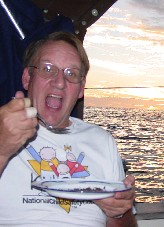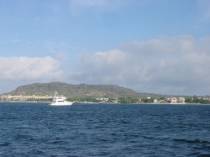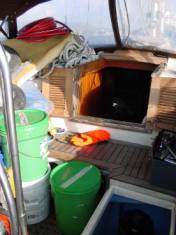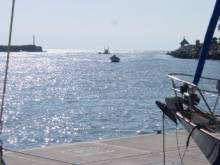|
Article describing the December 2001 passage of the s/v Elysium from San
Diego, California to Nuevo Vallarta, Mexico. Author Chris Stockard. |
|
The
Voyage of the Elysium – Oceanside, CA to Nuevo Vallarta, Mexico
I joined Joe in Oceanside, California in the first week of December 2001 to help him make the final leg of his delivery. The route would take us from Oceanside, just North of San Diego, along the length of the Baja Peninsula and across the mouth of the Sea of Cortez to Nuevo Vallarta. Since this was a delivery, our plan was to move as
far as possible, as fast as possible, with as few stops as possible.
Stops in Mexico become problematic because of requirements to check in
and out of every port with the local Port Captain, a long and bureaucratic
process. Our hope was that we could
slip into Bahia Tortuga (Turtle Bay) about 400 miles from San Diego for fuel
without bothering to do any of the bureaucratic process.
Since there were only two of us aboard we had to stand watch and watch all night. We found that three hour watches from 6pm to 6am and then a looser daytime schedule seemed to work fine. Sometime during the day each of us would get a couple of hour nap to add to the 4-5 hours we managed between watches at night. The strong winds of the preceding day’s storm had built up 4-8 foot swells that stayed with us until we were well south. On top of those swells, the NW winds also build up some shorter chop, which meant we had a ‘lively’ ride for the first couple of days. As evening came on the pleasant daytime temperature dropped rapidly so that by midnight the on-watch crew was wearing polypro long underwear, sweaters, hats and gloves as well as full foul weather gear to counter the wind chill. Each night as we worked our way further south we removed at least one layer, so that by the final night crossing the Sea of Cortez we were wearing only shorts and a long sleeved shirt and remaining perfectly comfortable. What a difference a thousand miles can make!
Up early the next morning we were able to see the sere
landscape surrounding Bahia Tortuga. Since
our object was to get fuel and get out we quickly moved to the neighborhood of
the fuel dock where
After fueling, we headed right back out to sea, setting a course that would take us offshore past Bahia Magdalena to Cabo San Lucas and then direct to Bahia Banderas and Nuevo Vallarta. With his many bandages, Joe looked a bit like the mummy, especially since every time he worked around the boat he would shed them and need rebandaging. The good weather continued along with moderate northerly winds so we quickly got back into the rhythm of our watches. Since we really didn’t want to stop again for fuel we reduced our engine rpm when we motorsailed for maximum economy. We enjoyed nice weather and the sunrise as we passed Bahia Magdalena.
Some who have traveled before with Joe may have heard
of his standard provisioning: bread, peanut butter, and lunchmeat.
Since his crew was unwilling to subject himself to such an extreme
hardship diet, we took full advantage of the newly installed
As we headed southeast across the mouth of the Sea of
Cortez we expected that we would enjoy clear skies and a reliable Northerly wind
to speed us on our way. We were
especially looking forward to the clear skies because moonrise was coming so
late that it was no longer providing much light in the nights. Instead of clear skies, we got increasing overcast and winds
from nearly where we were headed. Fortunately
the winds remained fairly light, so didn’t slow us too much, although we had
had to motorsail continuously to make good progress.
As night fell, so did deep darkness.
Even after ones eyes had adjusted to the darkness, the night was almost
totally black, at least until about 2 in the morning when the clouds began to
light up with lightening flashing deep inside them.
The clouds were quite spectacular and uncommon for the time of year and
location.
Heading away from Punta Mita we immediately noted the new ease of steering and improved autopilot function! The last 18 miles went quickly and we located the entrance channel to Nuevo Vallarta without much mystery (remember, the charts are off by a mile or so). The entrance is known for its shoaling bottom, and the dredge working in the channel was confirmation of the truth of this. We slipped through the entrance in water only a little over 6 feet deep. Once inside, the water was comfortably deep and we got tied up and settled into the Paradise Resort Marina. Paradise
Resort represented quite a change from the last time Joe was in Nuevo Vallarta. Lo those many years before there had been a small public
marina with room for 20-30 cruisers. Now
the public marina has expanded considerably, and the resort side has a marina
filled with many 60-80 foot power and sail yachts, as well as numerous
relatively prosperous smaller cruising boats.
The marina is adjacent to the resort with its three hotel buildings, 5
restaurants, ZOO, and numerous pools. Close
by are condo By the time we were tied up were told it was too late to begin the clearance process, so we left that until the morning. Bright and early Joe rowed the dinghy over to the Port Captain’s office arriving about 9:30. He was immediately told that the Port Captain wouldn’t be in until 9:00? Turns out that the Port Captain operates on time one hour later than the surrounding area. Go figure. After returning from the Port Captain we hired a taxi to take us into Puerto Vallarta to the immigration office. Naturally one can’t just go to the office. Instead one has to visit the office and get the appropriate forms, get them stamped and then take them to the bank where fees are paid. Then it’s back to the immigration office for the issuance of the visa. Not too bad by Central American standards, but pretty amazing for us nortamericanos. Then by cab back to the marina and Joe back to the Port Captain with his bank receipts and our visas to finish the check in process. Only 4 hours total, so not bad! All just in time for Chris to use that hard earned visa to leave for home the following day.
|
 Elysium
is a Tayana 37 owned by Joe Cottingham, recently of Juneau.
Elysium
is a Tayana 37 owned by Joe Cottingham, recently of Juneau. Before
starting we had to install a replacement refrigeration system in Elysium and
purchase the food for our passage.
Before
starting we had to install a replacement refrigeration system in Elysium and
purchase the food for our passage. We were also treated to visits from many types of
marine life.
We were also treated to visits from many types of
marine life. At about
midnight on the third evening we reached Bahia Tortuga, which we entered using
radar and the PC charts and GPS.
At about
midnight on the third evening we reached Bahia Tortuga, which we entered using
radar and the PC charts and GPS. we prepared to wait our turn.
we prepared to wait our turn. I should mention here that in addition to Joe’s
numerous cuts and abrasions, Chris was suffering from his chronic bad back.
I should mention here that in addition to Joe’s
numerous cuts and abrasions, Chris was suffering from his chronic bad back. After
two more days at sea Cabo Falco, and then Cabo San Lucas came in to view.
After
two more days at sea Cabo Falco, and then Cabo San Lucas came in to view. refrigeration to
stock both fresh and prepared foods.
refrigeration to
stock both fresh and prepared foods. For
several days we had commented at times that the autopilot seemed to wander a lot
from its assigned course, but that it always managed to get back to where it was
heading.
For
several days we had commented at times that the autopilot seemed to wander a lot
from its assigned course, but that it always managed to get back to where it was
heading. In the morning we were greeted by the prospect of
emptying the lazarette of all the gear to get to the steering gear.
In the morning we were greeted by the prospect of
emptying the lazarette of all the gear to get to the steering gear. locker and after a
couple of hours of grunting banging had tightened up the connection of the
steering quadrant to the rudderpost and restored normal steering.
locker and after a
couple of hours of grunting banging had tightened up the connection of the
steering quadrant to the rudderpost and restored normal steering. blocks and a large mall and supermarket.
blocks and a large mall and supermarket.